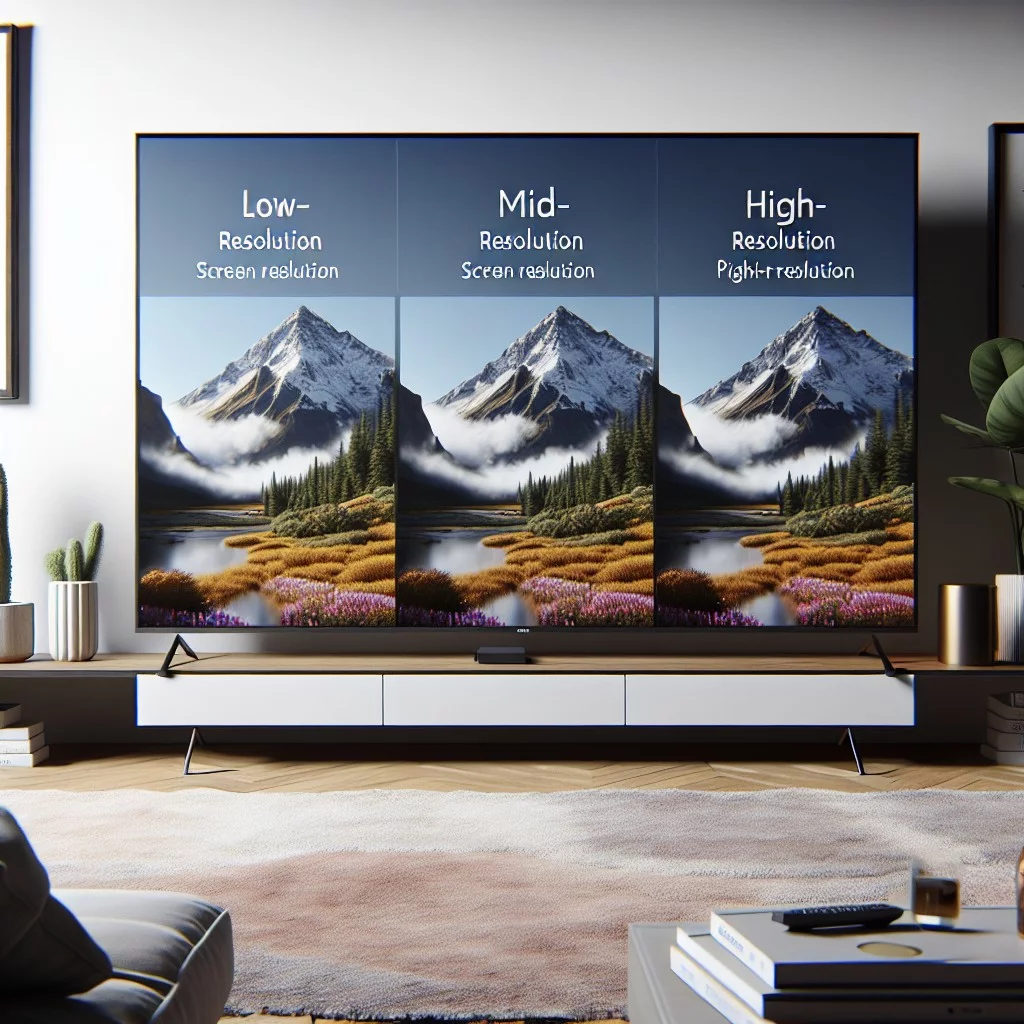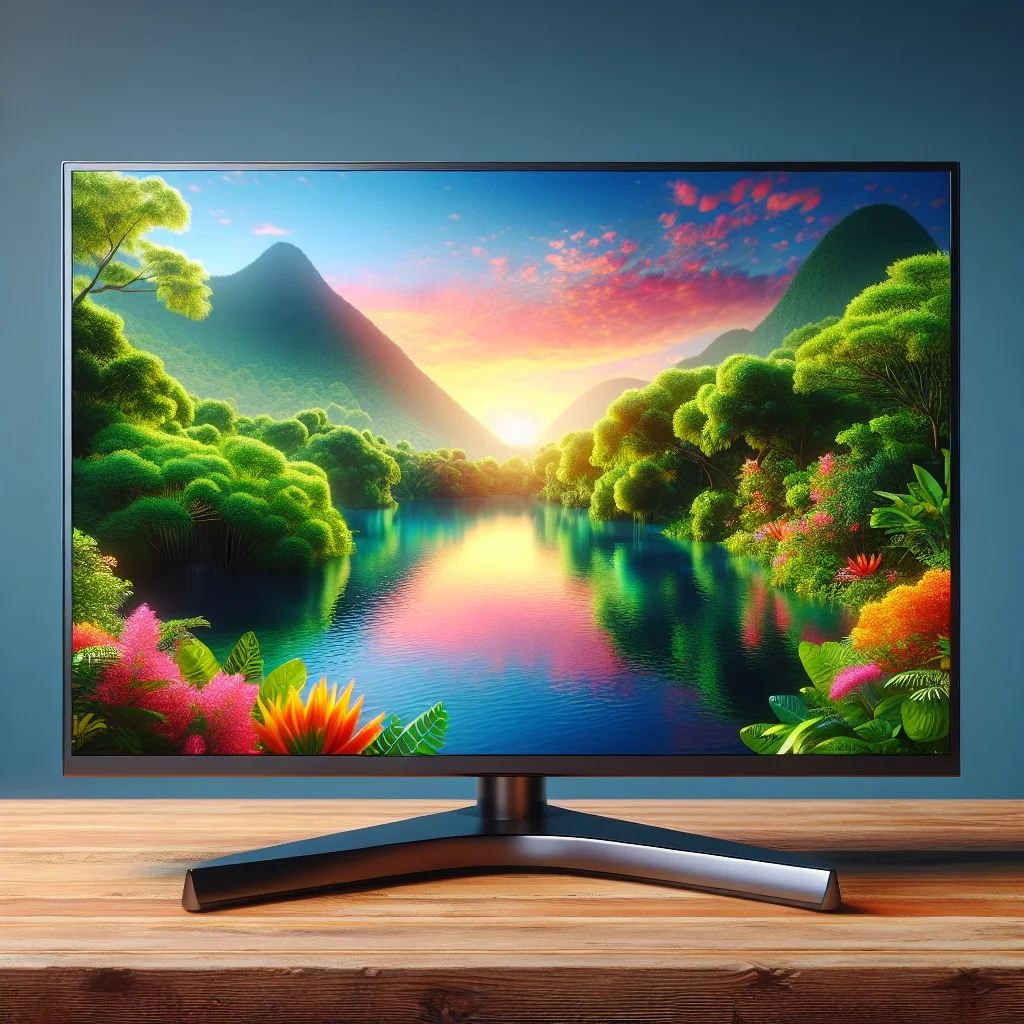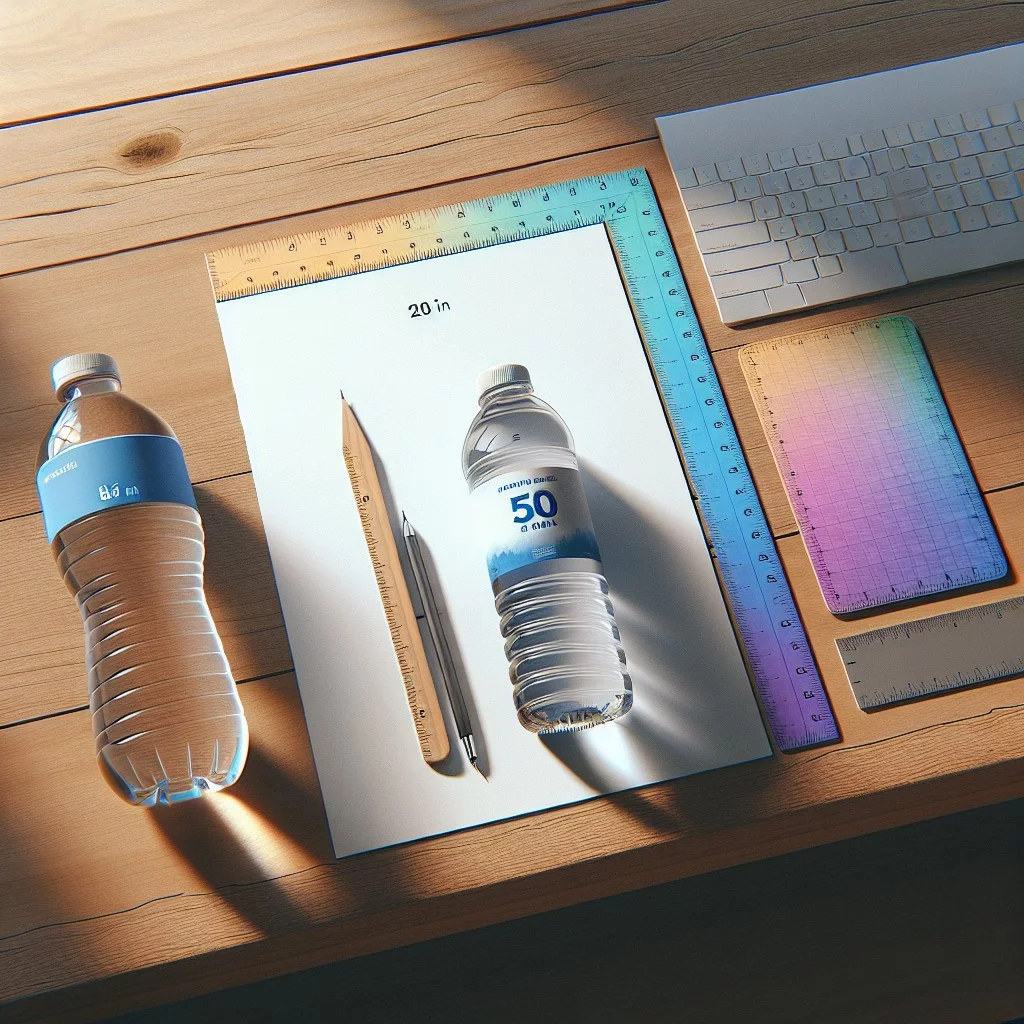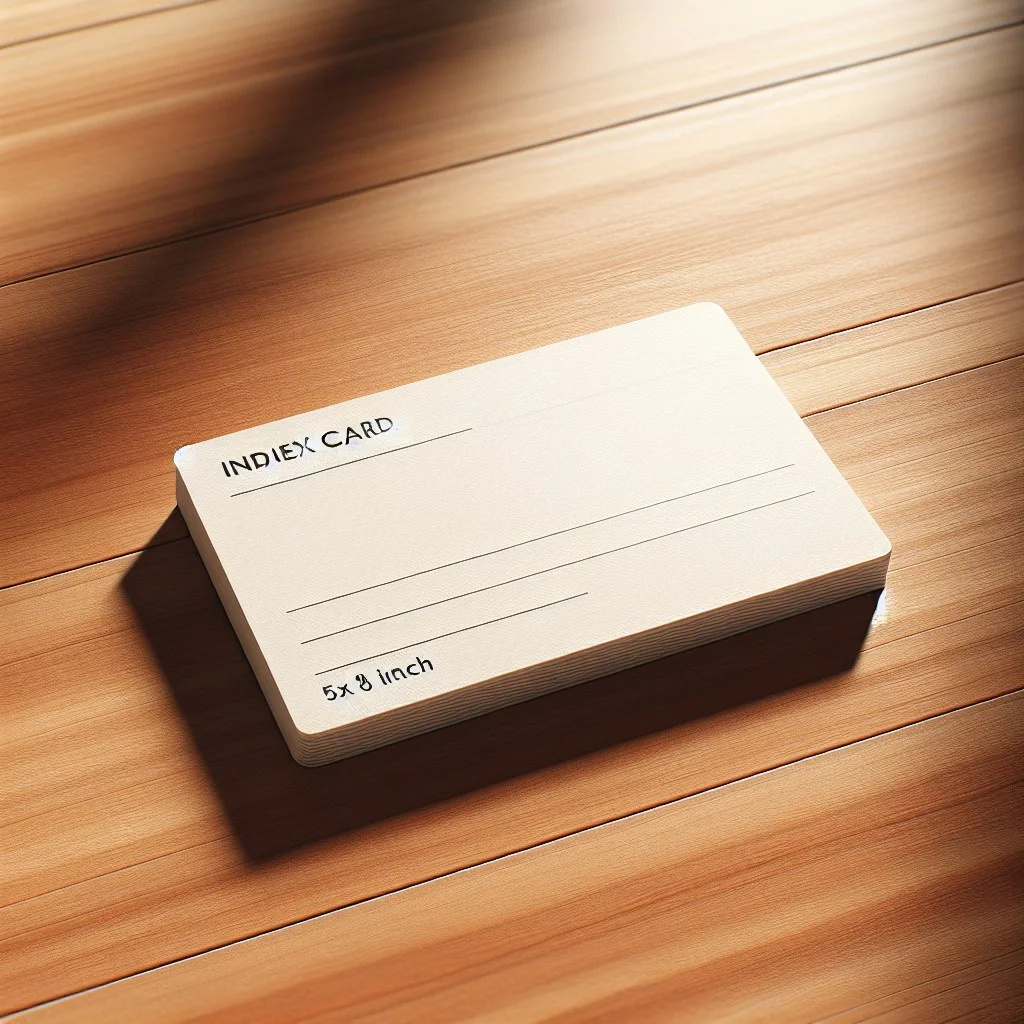Last updated on
Peeling back the layers of misconception, this article beautifully reveals the actual size of a 24-inch TV, comparing it with familiar everyday objects to provide a clear understanding.
Key takeaways:
- High-resolution visuals make a 24-inch TV seem larger.
- Most 24-inch TVs have a 16:9 aspect ratio.
- The actual width of a 24-inch TV is around 20.9 inches.
- The optimal viewing distance for a 24-inch TV is 3-4 feet.
- 24-inch TVs are lightweight and portable, weighing around 8-12 pounds.
What's Inside
Screen Resolution Impact On Perceived Size

High-resolution visuals on a 24-inch screen can trick the eye into perceiving more content than what you might expect from a display of this size. This is because, with higher pixels per inch (PPI), the TV can show finer details, making the image appear larger and more life-like.
For instance, a 24-inch TV with 1080p resolution (Full HD) will seem significantly more immersive compared to the same size screen with a 720p resolution (HD Ready). The sharpness and clarity of the images enhance the viewing experience, giving the impression of a more expansive display.
Moreover, the type of content being viewed plays a role. Fast-paced sports and video games with high-definition graphics tend to captivate viewers, making the screen feel ample despite its modest size.
Remember, a TV’s resolution is not just about how many pixels it has but also about how those pixels improve the overall visual experience. A higher resolution on a modestly sized screen can often be indistinguishable from a larger screen with a lower resolution when viewed from the right distance.
Aspect Ratio and Image Display

Aspect ratio is a term that’s essential when discussing screen sizes. It refers to the proportion between the width and height of the display.
Most modern TVs, including a 24 inch model, typically have a 16:9 aspect ratio. This is the standard for high-definition televisions and is perfectly suited for most viewing content, including movies, television shows, and video games.
When the aspect ratio is consistent, a 24 inch TV will display images without unnecessary letterboxing (black bars at the top and bottom of the screen) or pillarboxing (black bars on the sides). This ensures that the viewer gets the full experience of the content as it was intended to be seen, without any distortion or cropping.
One thing to note is that even though a TV has a diagonal measurement of 24 inches, this doesn’t mean the screen is 24 inches wide. The width is actually smaller and can be calculated by considering the aspect ratio. For a 16:9 display, the width will be about 20.9 inches, while the height will be approximately 11.8 inches. These dimensions are key for anyone trying to determine whether a 24 inch TV will fit in a specific space.
Understanding aspect ratio is vital because it affects compatibility with various content formats. Viewers looking for a more cinematic experience might also explore TVs with a 21:9 ratio, often referred to as “CinemaScope.” However, for most 24 inch TVs, the standard widescreen format of 16:9 will prevail, providing a balance between height and width that caters to a broad range of media.
Physical Dimensions of a 24 Inch TV
When measuring TVs, the screen size, such as 24 inches, represents the diagonal length from one corner to the opposite. Despite sharing the same diagonal measurement, TVs can have different physical dimensions based on their frame or bezel width. For a 24 inch model, the actual width typically hovers around 21.8 inches (55.4 cm), while the height is usually about 12.2 inches (31 cm), not considering the stand or mount. However, manufacturers nowadays often strive for, and manage to design, slimmer bezels, which leads to a more compact frame encasing the display.
The thickness of the TV is another dimension worth noting as it can vary depending on the technology used. A general estimation for flat-panel 24 inch TVs is a depth ranging from 1 to 3 inches (2.5 to 7.6 cm), which influences how unobtrusive the TV appears when wall-mounted.
Lastly, pay attention to the stand dimensions if you’re planning to place your TV on a console or table. Stands can sometimes extend beyond the width of the TV, necessitating a wider surface to rest on. It’s always recommended to check the complete dimensions given by the manufacturer to ensure the perfect fit for your space.
Viewing Distance and Optimal Sizing
When selecting a 24-inch TV, one critical consideration is the viewing distance, which directly affects the optimal sizing for your space. TV industry experts, like those from the Society of Motion Picture and Television Engineers (SMPTE), suggest a viewing distance where the screen occupies a certain area of your visual field for a fully immersive experience.
For a 24-inch screen, the sweet spot is typically around 3 to 4 feet (0.91 to 1.22 meters). At this range, the screen is large enough to be engaging, yet not so vast that you’ll have to constantly move your eyes or turn your head to see the entire image.
Beyond personal comfort, viewing distance also plays into image clarity. Sitting too close to a 24-inch TV, particularly one that doesn’t boast a high resolution, may result in individual pixels becoming discernible, disrupting the viewing experience. Conversely, sit too far away, and you might miss out on the intricate details that your television can display.
Lastly, consider the content you typically watch. High-definition or 4K content looks crisp even at closer distances, while standard definition benefits from a bit more space, making the pixels less noticeable.
Remember, these are guidelines to enhance enjoyment. Your ultimate guide should be what feels most comfortable to you within your specific viewing environment.
Mounting Space Considerations
When preparing to mount your 24-inch TV, it’s important to factor in the space where it will reside. While the screen size is 24 inches, measured diagonally, the actual width and height are typically around 21 inches by 12.5 inches, though this can vary slightly based on the bezel size. Ensure that the wall space can accommodate the TV with some room to spare to avoid a cramped look.
It’s also wise to consider the mount type. A fixed mount keeps the TV steady, but a tilting or full-motion mount requires additional space to accommodate the range of movement. Leave enough clearance around the TV to prevent bumping into adjacent objects when adjusting angles.
Cable management is another critical aspect. If the mount allows for internal routing, you’ll need extra space behind the TV. Otherwise, consider how external cable management solutions may affect the space requirement. Remember, having a plan for your cables keeps the area neat and tidy.
Lastly, think about the location of power outlets and the length of your TV’s power cable. The proximity to an outlet could affect how you position the mount, so you don’t stretch or inadequately tension the cable.
These mounting space considerations, when thoroughly thought through, will ensure a dedicated spot for your entertainment without last-minute spatial challenges.
Comparison of Popular Brands’ 24 Inch Models
When looking at the 24 inch offerings from popular brands like Samsung, LG, and Sony, subtle differences emerge that can influence a buyer’s decision.
Samsung’s models typically boast vibrant color accuracy and are equipped with their reputable Tizen OS for smart functionalities. Some feature a gaming mode, which optimizes the display for fast-moving action.
LG often incorporates their own WebOS, offering an intuitive interface for streaming. Their IPS displays are known for wider viewing angles, meaning the picture quality won’t deteriorate much when seen from the side.
Sony, on the other hand, tends to focus on sound quality as well as image clarity. Their models might include technologies like ClearAudio+ which enrich the auditory experience alongside a crisp Full HD display.
Each brand also has a unique approach to design. Samsung may offer sleek, almost bezel-less frames, while LG might focus on a more robust stand. Sony could excel in a more premium finish, giving an elegant look even to their smaller screens.
Ultimately, the choice among brands extends beyond mere size; it includes the nuances of design, smart capabilities, and additional features that enhance the viewing experience.
Weight and Portability of 24 Inch TVs
Considering their compact size, 24 inch TVs are a breeze to move around, opening a world of possibilities for placement in your space. Most models in this range tip the scales at a mere 8 to 12 pounds. This lightweight nature stems from the use of LED technology and slim, efficient designs by manufacturers aiming to enhance the portability factor.
With this in mind, rearranging your room layout doesn’t have to be a chore; these TVs can be shifted with ease. This also makes them ideal for spaces where a TV isn’t always necessary, like kitchens or offices, where they can be brought in for a specific purpose and then stowed away.
Their feathery weight simplifies the mounting process, too. No need for heavy-duty wall mounts – a simple, standard bracket will do the job, putting less strain on your walls. For students or renters frequently on the move, a 24 inch TV can be a game-changer, easily fitting into a car without needing a team to lift it.
It’s also worth noting that if you’re environmentally conscious or simply looking to save on energy bills, the lighter LED screens of these TVs are more energy-efficient, thus weighing less on both your conscience and your electricity consumption.
Understanding TV Size Measurements
When discussing a TV’s size, the measurement provided usually refers to the diagonal length of the screen, not including the bezel or casing. A 24-inch TV means the screen, from one corner to the opposite corner, is 24 inches. This measurement comes from the standard method used since the early days of CRT televisions.
Here’s what to keep in mind:
- Diagonal Measurement: The screen size is a diagonal measurement across the screen, from the top left corner to the bottom right corner or vice versa.
- Aspect Ratio: Most modern TVs have a 16:9 aspect ratio, meaning the width of the display is almost twice its height.
- Actual Viewing Area: The actual height and width of the screen will vary based on the aspect ratio. For a 24-inch screen with a 16:9 ratio, the width will be around 20.9 inches, and the height approximately 11.8 inches.
- Bezel Not Included: Remember, the bezel, the frame around the screen, doesn’t factor into the measurement. Hence, the actual device size will be slightly larger.
Being aware of these points will help avoid confusion when selecting a TV—knowing how measurements relate to actual size aids in making a more informed choice for your space.
Room Size and TV Placement
Choosing the right TV size for your room enhances comfort and viewing experience. For optimal viewing, a 24-inch TV fits best in small to medium-sized rooms. The recommended distance between the TV and your seating area is roughly 3 to 4.5 feet, ensuring you can enjoy the picture without straining your eyes.
When placing a 24-inch TV, consider the room’s layout:
- Height: Positioning the screen at eye level from your viewing spot prevents neck strain. A good rule is having the middle of the TV screen at seated eye level.
- Angle: Minimizing glare and reflections by avoiding direct opposite positions to windows or bright lights enhances picture quality.
- Furniture: Ensure there’s enough space on your TV stand or media unit to accommodate the TV’s base or stand.
- Wall Mounting: If you prefer wall mounting, choose a spot that isn’t exposed to excessive natural light and where the TV can securely anchor to wall studs.
- Surround Sound: If using external audio sources, like speakers, leave sufficient space for placement and sound propagation.
- Access: Keep enough room for any necessary cabling and for easy access to ports without moving the TV frequently.
By considering these factors, you’ll create a viewing area that’s both practical and enjoyable for a 24-inch TV.
Inch 16×9 Display Vs 27 Inch 16×9 Display
When considering a 24 inch display and a 27 inch display, both with a 16:9 aspect ratio, the comparison is often rooted in the overall viewing experience which includes screen real estate and resolution. The 16:9 aspect ratio is widespread, commonly associated with widescreen televisions and monitors.
Firstly, the diagonal measurement of a 27 inch TV is larger by 3 inches, a seemingly small difference that actually translates to about 25% more screen area. This increase substantially enhances the immersive experience for viewers, especially noticeable during cinematic viewings or while gaming.
Additionally, these displays typically maintain the same resolution, often 1920×1080 (Full HD), yet the pixel density is higher in a 24 inch screen due to the smaller area. This means the same number of pixels are spread over an expanded area in the 27 inch, which could result in a slight decrease in sharpness if viewed from the same distance. However, the larger screen can provide a more theater-like atmosphere in the right room setting.
Moreover, the larger screen size can positively impact multi-window or multi-tasking activities. More screen space allows users to comfortably work with multiple applications at once, a valuable asset for productivity.
It’s also pertinent to consider that the introduction of a 27 inch screen to a space previously occupied by a 24 inch could require reevaluation of your setup. Furniture might need rearranging to maintain optimum viewing distance, and additional space for the larger footprint should be ensured for a comfortable and aesthetically pleasing setup.
FAQ
Is a 24-inch TV small?
From the perspective of standard television sizes, a 24-inch TV is indeed considered small.
Is 24-inch TV big enough for bedroom?
A 24-inch TV is indeed adequately sized for a bedroom setting, considering measurements and typical viewing distances.
Is 24-inch TV too small for kitchen?
A 24-inch TV is an ideal size for a kitchen, providing an excellent balance of compactness for the typically limited space and sufficient screen size for enjoyable viewing.
What are suitable viewing distances for a 24-inch TV?
Suitable viewing distances for a 24-inch TV fall in the range of 3 feet (0.91 meters) to 6 feet (1.83 meters) for optimal visual comfort.
Can a 24-inch TV be effectively used as a computer monitor?
Yes, a 24-inch TV can be effectively used as a computer monitor.
Is a 24-inch TV a good option for children’s room or play area?
A 24-inch TV, particularly those with built-in parental controls and content filters, can be an ideal choice for children’s rooms or play areas, offering an ample screen size for their viewing without overpowering space.




